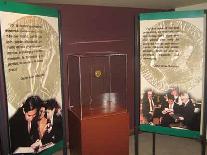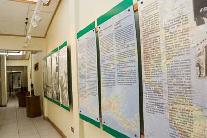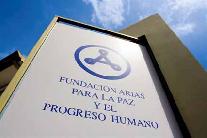AMERICAS
Arias Foundation for Peace and Human Progress/Museum for Peace (Costa Rica )
(Nov. 6, 2008)
by Niamh O’Grady, Assistant to the Executive Director
In 2003 the Arias Foundation for Peace and Human Progress opened the doors of its Museum for Peace in a strategic location in downtown San Jose. The museum occupies one side of the historic Plaza de la Democracia (Democracy Plaza) and is located between the National Legislative Assembly and the National Museum, a short walk from the Supreme Election Tribunal, the National Park, and the Supreme Court of Justice. The Plaza de la Democracia (Democracy Plaza) was constructed to commemorate both the first successful century of the Costa Rica democratic regime as well as the Hemispheric Summit of Presidents held in 1989 by then Costa Rican president Dr. Oscar Arias Sanchez. Dr. Arias dedicated the monetary portion of his prize toward continuing efforts at peace and development in Central America and he founded The Arias Foundation for Peace and Human Progress?in 1988. The goal of the summit was to encourage the region’s peace processes.
The Museum for Peace looks to contribute to a culture of dialogue, consensus, and reconciliation and is driven by a concept of peace as not simply the absence of armed conflict or violence but rather as a form of human progress, as much individual as collective, material as spiritual. The Museum is open to the general public as well as to researchers. In the two-story building visitors can find invaluable documentation about the process of negotiation and peace-brokering at Esquipulas II and its repercussions in the local and international press.
On the first floor one can find exhibits explaining the institutional trajectory of the Arias Foundation and its principle objectives and achievements. It is here that one can see a replica of the Nobel Peace Prize medal awarded to Dr. Arias Sanchez. In addition to informative films such as “People of Peace,” the projection room contains a photographic exhibition of past Nobel Prize Laureates created by renowned photographer Michelle Pelletier.
The second floor features an exhibition designed to reconstruct the historical memory of Central America and the Arias Plan for Peace in a manner that is clear and accessible to the visitor. The display about the evolution of the peace process begins with a brief explanation of the historical development of Central America along geographic, political, social, economic, and cultural lines. This explanation ensures a global comprehension of the phenomenon which sparked military insurrection and civil war, from clues about the identity and motives of the belligerent actors to explanations about the geopolitical context of the Cold War.
Displays further explore the contemporary history of Central America and focus primarily on the 1980s and the politico-military conflict in the region. In addition, students and teachers are offered a free guide brochure to help them understand the peace-building process in Central America.
Most of the documentary evidence and historical materials belonging to the Museum for Peace are now accessible in digital form. Visitors and researchers can access a digital catalogue of the publications of the Arias Foundation. Audio-visual materials are available about the Arias Peace Plan, as well as an electronic archive of documented information and international journalistic coverage of the Central American peace process.
To tackle the increasing rise of violence within our region, the Arias Foundation is currently constructing a Center for Conflict Resolution. The Center for Conflict Resolution will focus on addressing violence and both traditional and non-traditional conflicts through solutions aligned with the philosophy of peaceful resolution. Our model for the Center for Conflict Resolution employs a three-pronged approach equally emphasizing the principles: Prevention, Resolution, and Reconstruction. As part of our preventive approach we are creating an Interactive Center for Peace (ICP) with the aim of instilling visitors with a deep respect for peace and tolerance. The Interactive Center for Peace will include Peace Museum and an area for permanent and temporary expositions as well as an auditorium, a library, and administrative offices of the Arias Foundation. The ICP is envisioned as a place for reflection, dialogue, and analysis of changes necessary in order to strengthen peace and democracy in the world.
Address: Apartado: 8-6410-100 San Jose, Costa Rica
Tel: +506-2224-1919
Homepage: http://www.arias.or.cr/en/museum.php
Days closed: Saturday, Sunday, Holidays
Admission: Free
(Originally published on October 20, 2008)
 A replica of the Nobel Peace Prize medal awarded to Dr. Arias Sanchez is among the items on display. |  Inside the museum |  Outside the museum |
 Peace Museums of the AMERICAS
Peace Museums of the AMERICAS